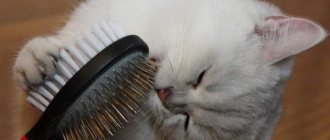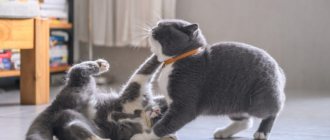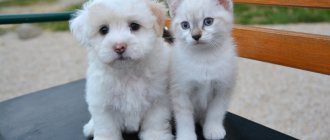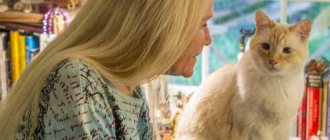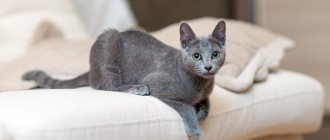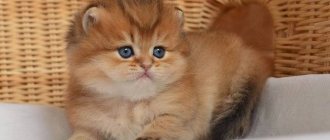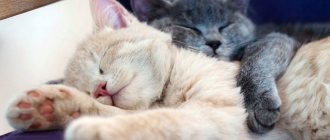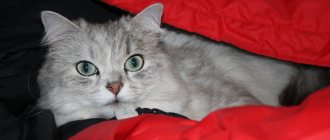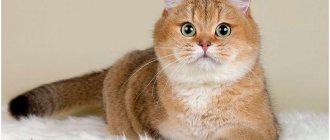A person who keeps pets gets sick 5 times less than other people. Whether the information is true or just speculation from pet lovers is unknown. But there is no doubt that the appearance of a British chinchilla cat will have a beneficial effect on the mood of all family members. The appearance, color of the plush beauty, character, habits, everything speaks about the difficult origin of the pet.
History of the breed
British breed cats were bred in England. Although cats were bred by continental Europeans, the animals were named after Great Britain. The name emphasizes the similarity of the color of the cat's fur with the color of the chinchilla.
There are 2 versions of the origin of the British chinchilla. According to one of them, cats were brought to the British Isles by the Romans. This version gives grounds to assert that this breed is one of the most ancient.
According to another version, cats were bred by the British, methodically crossing animals to get the desired result. For mating they used Persian and gray British cats. The breed was officially introduced in 1889.
The first individuals had a gray color, which was called silver color, later golden chinchillas appeared.
Origin
The breed was bred in Great Britain when, in the 70s of the last century, English breeders decided to cross Persian and British Shorthair cats. The idea was crowned with success - the result of the work done was unusually beautiful animals with luxurious fur and a squat, powerful physique. Soon all the necessary documentation describing the characteristics of the breed was fully approved. In 1980, the first official representative of the British chinchilla named Silver Lambkin was presented to the public, who later became the champion of many international exhibitions.
Description
British cats have a round muzzle and wide cheekbones. The animals have a rather large body. The eyes are large, expressive, of various shades of green. The nose is slightly flattened. The ears are small, the fur is thick and long. The neck is short. The limbs appear short due to the long fur on the belly. The pads are powerful and round.
Chinchilla cats tend to be overweight and are easy to overfeed. British chinchillas can hardly be called elegant and graceful. It's more like a cute little bundle of warmth and beauty.
Males are larger than females, the weight of an adult cat reaches 7 kg. Cats weigh around 4 kg. After castration, males gain weight and can weigh 10 kg or more. Females after sterilization weigh up to 8 kg.
The average life expectancy of a British chinchilla is 10-15 years. With good care, a pet lives 20 years.
How to cope with loneliness
An important advantage of the breed is the ability to enjoy not only a large company, but also loneliness. Yes, if you leave your pet alone for the whole day, you don’t have to worry that he will tear the upholstery on the sofa, knock over a flower and turn important documents into confetti. The British chinchilla calmly accepts loneliness and will take advantage of the free time to clean itself up, get a good night's sleep, sit on the window, calmly watching what is happening in the yard. In a word, an ideal pet for people with irregular work schedules.
Color
Experts note 3 main types of chinchilla color:
- golden;
- silver;
- silver shaded.
Less common are marbled, tortoiseshell, fawn, tabby, harlequin, bicolor, and cinnamon cats.
The golden chinchilla cat is less common than its silver relatives. This species has a reddish color on the back, sides and tail. The neck and belly are creamy.
Silver pets are white and 1/3 black. Silver shaded – white with fur darkened by 1/8.
Content
- History of the origin of the breed
- Description of the breed Appearance
- Genetics of chinchilla color and its varieties
- Character
- Possible breed defects
- Grooming
- Puberty and first mating
Relationship with the owner
Cats quickly find a common language with their owner and play with children. The British are prone to apathy. The chinchilla cat loves to be given attention and entertained.
If the owner is busy and cannot pay attention to the golden or silver chinchilla, it becomes offended and begins to get bored. The animal loves to be nearby when the owner is reading a book, watching TV, or doing homework. He will sit in your arms exactly as long as he wants.
The cat is imposing, allows itself to be stroked and scratched behind the ears. But he does not tolerate familiarity. As soon as the owner begins to squeeze the cat or tries to pat it, the pet expresses dissatisfaction. They are the kind of animals that allow themselves to be loved and set their own rules.
Character
British chinchilla cats are distinguished by aristocratic manners, calmness, and a good nervous system. Up to a year old, babies are very active and love to play. Adult pets are most often balanced and treat their owner as a friend. The British do not like to sit on their hands; they prefer to approach them themselves for a portion of affection.
Animals understand the situation very well and are able to manipulate the owner and family members. Plush beauties most often cannot stand strangers; there are known cases of hostility towards drunken visitors to the house. But by purchasing a British chinchilla cat, a person receives a devoted companion. The pet is attached to the house and can resort to tricks if the owner is forced to say goodbye to it. Sometimes they hide or pretend to be sick when strangers appear.
British Chinchillas get along well with other pets indoors. But the arrival of a new pet must be planned. It is necessary to separate the arriving baby from the old friend. Gradually allow animals to be together. If you do not provide for the behavior of pets, you can get sick and sick in cats.
British chinchillas are prone to depression. They buy toys and mazes for the animal. A mobile, active pet eats well and looks great.
The description of the breed and character of the British chinchilla shows: pets get along well with children. But you should not allow your child to squeeze and knead the baby immediately after coming into the house. The furry baby is given time to get used to the new home, food, smells and sounds.
Mobility
Aristocratic chinchillas would rather lie imposingly than rush around the house. Although they are not averse to frolic, but in moderation. There are no special transition stairs for them, no ropes are laid out so that they have somewhere to spend excess energy. These are pets that decorate the house.
In Western countries, an owner is considered bad if a domestic cat has less than 2 toys. There is no need to count the number of cute objects our cats have, but the animal will feel better if it has its own toys. Stores offer active and educational games for cats. The British are considered to have intelligence. Devices that develop logic have been developed for them. Toys will have to be updated periodically.
Kittens
British breed babies do not have clearly defined coat and eye colors. In childhood, the fur of a golden chinchilla cat can be distinguished. The animal is finally formed by the age of 1.5 years. In an adult animal, the color of the fur and eyes is visible, and it no longer changes with age.
For kittens to develop normally, food must be age appropriate. It is better to use ready-made dry and wet food. Kittens should not be fed cow's milk. For them, it is better to use goat’s milk or diluted in a ratio of 1:3 (where 3 parts are cow’s milk).
Golden Chinchilla Standards
For the first time, the golden chinchilla color was included in the standard of Persian cats. Now it is found in many breeds for which the silver chinchilla color is recognized.
Preference is given to cats with a uniform golden undercoat without a gray area at the roots. When the color first appeared, such animals were still used for breeding, but now they are increasingly not allowed to breed.
There is no single standard regulating the color of the golden chinchilla. Experts evaluate animals in accordance with documents approved for a specific breed by the World Cat Federation:
- British cats are stocky, massive and muscular. The head is round, with a wide skull and pronounced cheeks. The ears are small, set wide, and the tips are slightly rounded. The tail is thick and curves upward. The coat is raised, dense and short.
- Scottish - divided into fold-eared (Scottish fold) and straight-eared (straight). The first ones have small ears, the tips hanging forward. The limbs are short and thick. Straights have erect ears and can be small or medium in size. The limbs are slightly longer and lighter.
- Persian - distinguished by rectangular body lines. Legs are strong and short. The head is large, the forehead is sloping (other chinchillas have a rounded forehead).
Golden chinchillas have ears covered with dense and short fur. The eyes are very large and expressive.
Bathing
These cats don't like to swim. To keep the coat in good condition, British chinchillas are treated with dry shampoo. The composition is applied to the wool, rubbed in, then combed out with a brush. The powder removes dust, cares for hair, and creates volume. The procedure is performed 2 times a year. Shampoo is selected depending on the shade of the coat. A golden chinchilla will not benefit from a product intended for a pet with silver fur.
British chinchillas do not tolerate regular bathing well. If it is not possible to use dry shampoo, be prepared for a negative reaction from your pet to water. To create maximum comfort, a cloth is placed under the cat's paws. The animal clings to the lining with its claws, does not slip and feels more calm.
When bathing your Briton, make sure that the shampoo does not get into the eyes and ears.
Interesting photo
British chinchilla in all its glory
Silver British Chinchilla
Initially, kittens are born with tabby color.
Golden British Chinchilla
British chinchilla color options
Hygiene
The chinchilla cat quickly learns to use the litter box. Sand or filler is changed frequently. If the animal feels that the litter is stale, it will find a corner and relieve itself there. Don't scold the British in this case.
Ears and eyes require special care. The ears are cleaned with a cotton swab moistened with warm water once a week or as they become dirty. The eyes are wiped with a cotton pad soaked in warm water. You can use wet wipes for this if they do not contain fragrances or other synthetic additives. They can harm your cat's mucous membranes.
The claws are cut off as needed using a nail clipper. If they peel off, it means that the diet requires correction and the chinchilla does not receive the necessary nutrients. To keep claws in good condition, make a scratching post at home.
Owner reviews
To get a complete picture of the breed, it would be a good idea to collect reviews from owners who are well aware of the advantages and disadvantages of British chinchillas.
Many of them note their excellent appearance. Not every breed can boast of such attractiveness. Plus, they look incredibly cute. The owners also note good health - with proper care, they rarely need to seek help from a veterinarian. A calm character and peaceful attitude towards children are perceived as additional advantages to the above.
True, speaking about the positive features of the breed, many also note the high cost - after all, this is an important disadvantage. And not every breeder likes a wayward character - many prefer more docile and obedient pets.
Concluding the article, we can say with confidence that the British chinchilla is an excellent breed. Willful and intelligent, friendly and beautiful, such a cat will become a faithful friend and decoration of any home.
Nutrition
To keep your pet's coat in good condition, the British chinchilla needs special nutrition. The best option is dry food. It is chosen depending on the age and gender of the pet.
Castrated and sterilized animals require special food. Manufacturers produce food for such animals. If feeding is homemade, it should be low-calorie, since processed animals are famous for their large appetites and are prone to becoming overweight. In addition, their hormonal levels are disrupted and this is taken into account when feeding.
If you plan to use homemade food, the chinchilla’s menu should include cereals, meat, fish (sea, as river fish can have parasites), and vegetables. Raw meat should not be given to cats. The product may contain worm eggs, and the animal will become infected with parasites.
A Briton should have constant access to clean water and his dishes should always be clean.
To keep their fur in good condition, cats are given eggs. Natural proteins and protein strengthen the roots, hairs do not grow so abundantly. With this diet, the fur of a silver or golden chinchilla becomes shiny and denser. Quail eggs are preferable to chicken eggs. But not everyone can afford to feed their cat quail eggs.
Persian
Persian chinchillas are slightly smaller than their counterparts. They are harmoniously built, distinguished by fine bones and elegance, but at the same time strong and resilient. In the USA, larger cats are bred, which are very similar in size and build to standard Persians.
The coat of Persian golden chinchillas is long and dense. The fur shimmers beautifully in the light. The cat may have emerald or bluish eyes with a brown rim. The soft pink nose is small and neat.
Health
British chinchillas are distinguished by good health. These are hardy animals that are not afraid of frost and wind. Warm and thick wool reliably protects pets from the vagaries of the weather. But it’s better not to take your fluffy for a walk in the rain or slush.
Like all cats, chinchillas suffer from kidney disease. Bring your pet to the veterinarian periodically to detect pathology at an early stage.
The British have watery eyes, and this is taken into account when purchasing a kitten, since the eyes will require care.
Predisposition to diseases
The British Shorthair has a long history, and one of the results of meticulous selection is that these animals have excellent health and excellent disposition. This is a long-lived breed. However, due to crossbreeding with Persian cats, some members of the chinchilla variety sometimes have kidney disease, although this is not common.
Polycystic kidney disease and blood type B
In the 20th century, British Shorthair breeders used Persian cats to create a chinchilla line.
Persians are prone to an inherited kidney disease called polycystic kidney disease. Since then, outbreaks of this disease have been periodically reported in the UK. A more common problem for British cats is the rare blood type that some of these cats have. British Shorthairs can be Type A or Type B. Most have Type A blood. Some have Type B. It is not a blood disorder, and Type B cats are just as healthy as Type A cats. But for breeding purposes or if blood transfusions are needed this must be taken into account. Type A blood will kill a cat with type B blood and vice versa. British shorthair breeders are worried about blood type due to "fading kitten" syndrome. When the mother cat has type B blood and the father of the kittens has type A blood, their kittens can have both type A and type B blood. Mother's milk contains antibodies to type A, which will kill type A kittens within 72 hours. Fortunately, there is now a DNA test to check the blood type before breeding a cat.
Subtleties of choice
Golden chinchillas are more expensive than silver cats. To avoid disappointment in your pet:
- buy a kitten from trusted breeders;
- find out who the kitten's parents are;
- find out in what conditions the baby is growing up and what illnesses the parents had;
- ask when and what vaccinations the kitten received;
- good breeders have passports for all animals - when buying a small animal, ask to see its passport;
- check deworming data;
- if the baby costs less than $400, this indicates a defect in the breed, or a half-bred animal;
- There are no British fold chinchillas (Scottish chinchillas have this feature);
- If you do not plan to participate in exhibitions, pay more attention to the health of the baby, and not to the color.
In order for the kitten to develop normally, it is kept with its mother for up to 3 months. Younger animals should not be purchased.
The British chinchilla will become a good friend who does not tolerate fuss. Complaisant and not very active pets will happily lie next to their owner, play with the child, but will communicate on their own terms.
Castration and sterilization of British chinchillas
At what age is it recommended to have surgery?
The procedure is done upon reaching 8 months. Before the operation, a consultation with a veterinarian is necessary, who will examine the pet and make a conclusion about its health.
Caring for your pet after surgery
After the castration operation is completed, your pet must be constantly monitored. Competent care consists of the following points:
- Limit physical activity.
- Ensure silence in the house.
- Do not give food for 8 hours after removal of the genitals.
- Purchase and put a special collar on the animal to avoid licking the wound.
- Regularly treat the seam with hydrogen peroxide.

